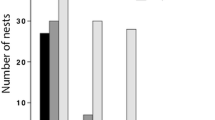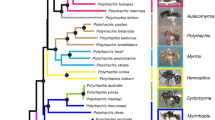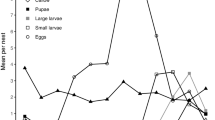Summary
Phylogenetic studies are required to establish the direction of evolutionary change in behavioral characters. Here I produce a phylogeny for 8 Old World species of the subgenus Evylaeus based upon cladistic analysis of 26 informative allozyme loci. By mapping behavioral character states upon the resulting cladogram, the following major conclusions could be drawn: (1) Social Evylaeus species share sociality by descent from a eusocial common ancestor which might not have been an Evylaeus species; the solitary behavior of Lasioglossum (E.) fulvicorne may be a derived condition. (2) One reversal to solitary behavior within Evylaeus is proven for a Japanese montane population of L. (E.) calceatum. (3) The perennial societies of L. (E.) marginatum are derived from an annual social cycle and do not represent an independent evolution of sociality. (4) Multiple-foundress associations are a derived condition within Evylaeus, suggesting that if social behavior evolved within the group, then the semisocial route was not the one taken by these bees. (5) The nest architectural trait of excavating a cavity around clustered brood cells is a ground plan characteristic of Evylaeus but with a reversal in L. (E.) marginatum. (6) It is likely that extended opening of brood cells during juvenile development has originated independently twice among the species considered. Another benefit of phylogenetic studies is their use in predicting which taxa are most likely to exhibit particularly interesting behavioral states. In this regard, the phylogeny suggests that close relatives of L. (E.) fulvicorne and also most of the major species groups of Evylaeus which have not received any field study should be investigated both phylogenetically and behaviorally for a full evaluation of behavioral evolution in Evylaeus.
Similar content being viewed by others
References
Batra SWT (1964) Behavior of the social bee, Lasioglossum zephyrum, within the nest (Hymenoptera: Halictidae). Insect Soc 2:159–186
Batra SWT (1968) Behavior of some social and solitary halictine bees within their nests: a comparative study (Hymenoptera: Halictidae). J Kans Entomol Soc 41:120–133
Batra SWT (1990) Bionomics of Evylaeus comagenensis (Knerer and Atwood) (Halictidae), a facultatively polygynous, univoltine, boreal halictine bee. Proc Entomol Soc Wash 92:725–731
Buth DG (1984) The application of electrophoretic data in systematic studies. Ann Rev Ecol Syst 15:501–522
Carpenter JM (1989) Testing scenarios: wasp social behavior. Cladistics 5:131–144
Coddington JA (1988) Cladistic tests of adaptational hypotheses. Cladistics 4:3–22
Do-Pham TT, Plateaux-Quénu C, Plateaux L (1984) Étude comparative des genitalia males de quelques Halictinae (Hymenoptera): répercussion éventuelle sur la classification. Ann Soc Entomol Fr 20:3–46
Eickwort GC, Sakagami SF (1979) A classification of nest architecture in the tribe Augochlorini (Hymenoptera, Halictidae, Halictinae), with a description of a Brazilian nest of Rhinocorynura inflaticeps. Biotropica 11:28–37
Farris JS (1988) Hennig: Hennig 86 reference, version 1.5. Computer program documentation published by the author
Farris JS (1989) The retention index and the resealed consistency index. Cladistics 5:417–419
Greenberg L, Buckle GR (198) Inhibition of worker mating by queens in a sweat bee, Lasioglossum zephyrum. Insect Soc 20:347–352
Knerer G (1980) Biologie und Sozialverhalten von Bienenarten der Gattung Halictus Latreille (Hymenoptera, Halictidae). Zool Jb Syst 107:511–536
Knerer G, Plateaux-Quénu C (1966) Sur l'ímportance de l'ouverture des cellules à couvain dans l'évolution des Halictinae. C R Acad Sci 263:1622–1625
Knerer G, Plateaux-Quenu C (1970) The life cycle and social level of Evylaeus nigripes, a Mediterranean halictine bee. Can Ent 102:185–196
McGinley RJ (1986) Studies of Halictinae (Apoidea: Halictidae). I. Revision of new world Lasioglossum. Smithson Contrib Zool 429:1–294
Michener CD (1974) The social behavior of the bees. Belknap, Cambridge
Michener CD (1985) From solitary to eusocial: need there be a series of intervening species? Fortschr Zool 31:293–305
Michener CD (1990) Reproduction and castes in social halictine bees. In: Engels W (ed) Social insects: an evolutionary approach to castes and reproduction. Springer, Berlin Heidelberg New York, pp 75–119
Mickevich MF, Mitter C (1981) Treating polymorphic characters in systematics: a phylogenetic treatment of electrophoretic data. In: Funk VA, Brooks DR (eds) Advances in cladistics 1. New York Botanical Garden, New York, pp 45–58
Murphy RW, Sites JW, Buth DG, Haufler CH (1990) Proteins I: isozyme electrophoresis. In: Hillis DM, Moritz C (eds) Molecular systematics. Sinauer. Sunderland, pp 45–126
Packer L (1986a) Aspects of the social biology of Halictus ligatus Say (Hymenoptera; Halictidae). Ph.D. thesis, University of Toronto
Packer L (1986b) The biology of a subtropical population of Halictus ligatus Say (Hymenoptera: Halictidae). II. Male behaviour. Ethology 72:287–298
Packer L, Knerer G (1985) Social evolution and its correlates i n bees of the subgenus Evylaeus (Hymenoptera; Halictidae). Behav Ecol Sociobiol 17:143–149
Packer L, Knerer G (1986) An analysis of variation in the nest architecture of Halictus ligatus in Ontario. Insect Soc 33:190–205
Packer L, Owen RE (1989a) Allozyme variation in Halictus rubicundus (Christ): a primitively social halictine bee (Hymenoptera: Halictidae). Can Entomol 121:1049–1058
Packer L, Owen RE (1989b) Notes on the biology of Lasioglossum (Evylaeus) cooleyi (Crawford), an eusocial halictine bee (Hymenoptera; Halictidae). Can Entomol 121:431–438
Packer L, Owen RE (1990) Allozyme variation, linkage disequilibrium and diploid male production in a primitively social bee, Augochlorella striata (Hymenoptera; Halictidae). Heredity 65:241–248
Packer L, Jessome V, Lockerbie C, Sampson B (1989a) The phenology and social biology of four sweat bees in a marginal environment: Cape Breton Island. Can J Zool 67:2871–2877
Packer L, Sampson B, Lockerbie C, Jessome V (1989b) Nest architecture and brood mortality in four species of sweat bee (Hymenoptera; Halictidae) from Cape Breton Island. Can J Zool 67:2864–2870
Pesenko YA (1985) A subgeneric classification of bees of the genus Halictus Latreille sensu stricto (Hymenoptera; Halictidae). Entomol Rev 63:1–20
Plateaux-Quénu C (1959) Un nouveau type de société d'insectes: Halictus marginatus Brullé. Ann Biol 35:235–444
Plateaux-Quénu C (1973) Construction et évolution annuelle du nid d' Evylaeus calceatus Scopoli avec quelques considérations sur la division du travail dans les sociétés monogynes et digynes. Insect Soc 20:299–320
Plateaux-Quenu C (1989) Premières observations sur le charactère social d'Evylaeus albipes F. (Hymenoptera, Halictinae). Actes Coll Insectes Sociaux 5:335–344
Platnick NI (1989) An empirical comparison of microcomputer parsimony programs. II. Cladistics 5:145–161
Poursin J-M, Plateaux-Quenu C (1982) Niches écologiques de quelques Halictinae I. Comparaison des cycles annuels. Apidologie 13:215–226
Ridley M (1983) The explanation of organic diversity: the comparative method and adaptations for mating. Clarendon Press, Oxford
Ridley M (1986) The number of males in a primate troop. Anim Behav 34:1848–1858
Sakagami SF (1974) Sozialstruktur und Polymorphismus bei Furchen-und Schmalbienen (Halictidae). In: Schmidt GH (ed) Sozialpolymorphismus bei Insekten. Verlagsgesell, Stuttgart, pp 257–293
Sakagami SF, Fukuda H (1989) Nest founding and nest survival in a eusocial halictine bee, Lasioglossum duplex: additional observations. Res Popul Ecol 31:139–151
Sakagami SF, Hayashida K (1960) Biology of the primitive bee, Halictus duplex Dalla Torre. II. Nest structure and immature stages. Insect Soc 7:57–98
Sakagami SF, Michener CD (1962) The nest architecture of the sweat bees. University of Kansas Press, Lawrence
Sakagami SF, Munakata M (1972) Distribution and bionomics of a transpalaearctic eusocial halictine bee, Lasioglossum (Evylaeus) calceatum, in northern Japan, with reference to its solitary life cycle at high altitude. J Fac Sci Hokkaido Univ Ser 6 [Zool] 18:411–439
Sakagami SF, Hirashima Y,Maeta Y, Matsumura T (1982) Bionomic notes on the social halictine bee Lasioglossum affine(Hymenoptera, Halictidae). Esakia 19:161–176
Sanderson MJ, Donoghue MJ (1989) Patterns of variation in homoplasy. Evolution 43:1781–1795
Sitkidov AA (1988) Nesting of the bee Halictus quadricinctus (F.) (Hymenoptera, Halictidae) in the Udmurt ASSR. Entomol Rev 66:66–77
Smith BH, Weller C (1989) Social competition among gynes in halictine bees: the influence of bee size and pheromoneson behavior. J Insect Behav 2:397–411
Svensson BG, Ebmer AW, Sakagami SF (1977) Lasioglossum (Evylaeus) boreale, a new halictine (Hympenoptera: Apoidea) species found in northern Sweden and on Hokkaido, Japan, with notes on its biology. Entomol Scand 8:219–229
Swofford DL, Berlocher SH (1987) Inferring evolutionary trees from gene frequency data under the principal of maximum parsimony. Syst Zool 36:293–325
Wilson EO (1971) The insect societies. Harvard University Press, Cambridge
Yanega D (1988) Social plasticity and early diapausing females in a primitively social bee. Proc Natl Acad Sci USA85:4374–4377
Author information
Authors and Affiliations
Rights and permissions
About this article
Cite this article
Packer, L. The evolution of social behavior and nest architecture in sweat bees of the subgenus Evylaeus (Hymenoptera : Halictidae): a phylogenetic approach. Behav Ecol Sociobiol 29, 153–160 (1991). https://doi.org/10.1007/BF00166396
Received:
Accepted:
Issue Date:
DOI: https://doi.org/10.1007/BF00166396




